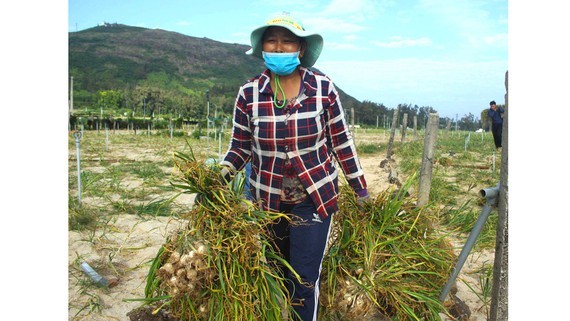
Ly Son garlic is dubbed the “white gold” of garlic in Vietnam for its distinct flavor that is natural to the island of Ly Son.
Even though a collective trademark for Ly Son garlic has been in place for 10 years, it is not enough to fully deal with fake products.
Local authorities since the beginning of 2020 have sanctioned 6 violations where people transport garlic from other regions into Ly Son island to sell under the protected brand name. They tried to disguise their cargo by putting fruits or seafood on top of the garlic, and some even claimed they were bringing the garlic to their family as gifts, said Vice Chairman of the People’s Committee Dang Tan Thanh. “We will not let anyone get away with bringing garlic from mainland onto Ly Son island under any guise”, he stated.
However, the Ly Son Garlic Geography Indicator scheme points out that authorities cannot forbid other types of garlic from entering the island, since garlic is not a restricted item and can be traded like any commodity. Mr. Thanh also admitted that the local police force is short on personnel, therefore not every ship entering Ly Son port can be thoroughly checked.
Ly Son garlics have been farmed on Cu Lao Re (now Ly Son island) since the 60s, but now the brand’s credibility is being affected due to the abundance of imitation products on their turf. Buyers are more skeptical and there have been several price drops in recent years. In 2018, 250 tons of dry garlic were left in stock, and prices hit record low for months - only VND25,000 per kilogram (about US$1.2).
Dinh Huu Phi, Director General of the Intellectual Property Office, Ministry of Science and Technology believes the recently given certificate will improve the reputation and credibility of Ly garlic, thus creating more jobs for the locals.
After building a Geographical Indication for its garlic, Ly Son authorities and citizens must come together to set up identifying criteria, standards and origins for authentic garlic. Packages must be affixed with labels and stamps to build consumers’ trust, he added.
A man from Tay An Vinh village in Ly Son District expressed that he wanted the Geographical Indication to protect the rights of farmers who directly cultivate the garlic, because harvests usually go straight to small traders with no packaging.
When asked about measures against fake products, Vice Chairman Thanh explained that the Geographical Indication would be the primary legal and commercial basis in dealing with fake products, and that the People’s Committee would raise locals’ awareness on how to protect the brand themselves.
























